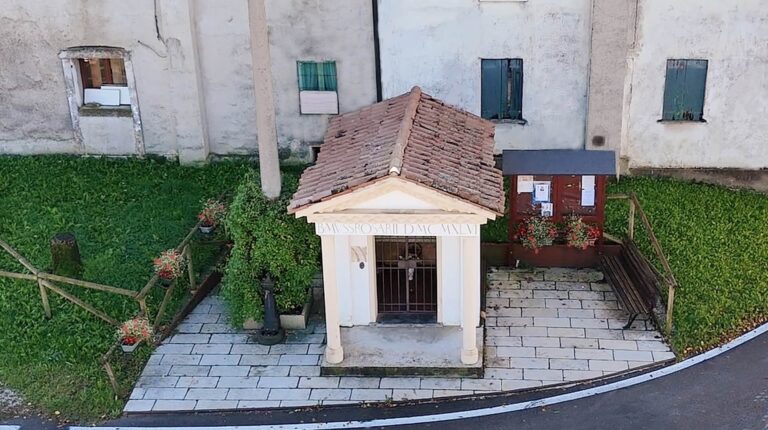ARTISTS’ ROADS
LE VIE DEGLI ARTISTI
watch the videos at the bottom of the page!
REFRONTOLO
A Wayside Shrine to the Madonna for Grace Received
Travelling along Via della Vittoria from Pieve di Soligo, deep in the heart of the Conegliano Valdobbiadene Hills, the historic centre of Refrontolo appears perched atop a gentle rise. From this natural balcony, one can admire Mount Grappa, the silhouette of the Prealps, and, on the other side, the long, sweeping course of the River Piave.
In Refrontolo, nature still stirs what the poet Andrea Zanzotto called a “most fertile wonder.” Woods, meadows and vineyards alternate across the landscape, and for more than five hundred years this land has produced the “excellent Marzemino” of Mozartian fame, now known as “Passito di Refrontolo”. Its exceptional quality owes much to the particularly dry, breezy climate, ideal for the natural drying of the grapes.
Refrontolo has long been and still is a welcoming place, the kind that clings to the soul. It is this search for inner peace and quiet that has led many, over time, to settle here. Among them was the painter Emma Ciardi, who found renewed creative energy in these hills.
Among the sacred signs that punctuate the landscape is a small shrine dedicated to the Blessed Virgin of the Rosary.
A black-and-white photograph takes us back in time and reveals its story.
2 April 1947.
It is a Wednesday in spring, and Refrontolo is celebrating. This small printed card captures and preserves each face. Present in absence, many of them now nameless. Yet what they embody endures: a community reunited in joy at the return of peace. This photograph bears witness to it
More than that. It enshrines this moment across time and space.
It is not merely a structure, not just a sacred building. It is an ex voto, a tangible sign of gratitude for protection received.
It all began in 1944.
In Refrontolo, the bodies of two German officers were discovered. Immediately, Mayor Angelo Fregolent and the parish priest Don Carlo Ceschin travelled to the Carabinieri station in Pieve di Soligo to report the tragic find, driven by a strong sense of civic and moral duty, but also by fear of possible reprisals against their community.
For a long time, the townspeople gathered to pray in the parish church, entrusting themselves to the Virgin through the recitation of the Rosary. At the war’s end, in thanks for the grace received, Refrontolo kept its promise and offered a shrine to the Madonna of the Rosary.
The mayor donated the land, in Via Casale. A building contractor by trade, he worked alongside many willing citizens to bring it to life.
On the little altar is the image of the Madonna of the Rosary, cradling the sleeping Child in a lakeside landscape, framed by depictions of the 15 Mysteries.
On the interior walls of the shrine are life-sized painted figures: an elderly man with a long white beard, a young farmhand, an old woman fingering her rosary beads, a little girl kneeling with hands clasped in prayer, and a young veiled woman. It is a portrait of a diverse humanity gathered in prayer before the Virgin and her Child, seeking comfort and strength.
An angel holds a parchment. His fingers partly conceal the inscription: Jucundus.
It is a playful way for the artist to sign his work: Giocondo Protti, physician and painter. An eccentric and imaginative man, he came to Refrontolo through family ties… and fell in love with it so deeply that he chose it as his final home.
MORE EXPERIENCES!
Refrontolo e dintorni: le dimore storiche:
- Villa Ticozzi – Ciardi
- Villa Spada
- Villa Capretta
- Villa Fabris a Solighetto
MULTIMEDIAL MAP: “ARTISTS’ ROADS – LE VIE DEGLI ARTISTI- EN”!

